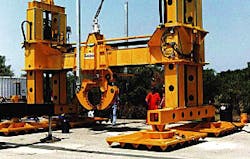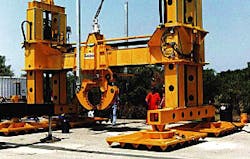Deepwater pipeline-repair system deployed to Mediterranean
Warren R. True
Pipeline/Gas Processing Editor
These H-frames provided support for the deepwater pipeline to be repaired with the Arcos diverless pipeline repair system.The latest phase in development of a deepwater pipeline-repair system received full-scale trials earlier this summer in Norway and has been deployed on standby for the Trans-Mediterranean pipeline by operator SNAM.
In Stavanger harbor in June, Sonsub International Inc.'s Arcos diverless repair system underwent successful shallow-water trials that employed all the system's equipment. ("Arcos" is an Italian acronym for "attrezzaturre per la riparazione di condotte sottomarine"-subsea pipe repair tooling.)
The system is the most recent development in an evolution of efforts to develop a diverless pipeline-repair system for deepwater use.
The prototype PRS (pipeline repair system) received deepwater (300 m) trials offshore southern Italy in 1992. It used two work-class ROVs.
In 1995, a modified PRS, renamed the DSRS (diverless sealine repair system), underwent shallow-water trials, also offshore southern Italy, that led to a modification of its pipe-lifting system.
In 1997, the DSRS underwent more shallow-water trials, this time in Stavanger, which led to improvement in the spool-installation module.
According to Sonsub, this refined version of the Arcos employs a "low-force modular" concept that is ROV supported and can be adapted quickly and easily to a wide range of pipe sizes.
The system tested in Stavanger this year was for a 26-in. line, the same size as the Trans-Med. Water depths on the Tunisia-Sicily pipeline reach 600 m.
Procedure
Simplified, the repair procedure involves the following steps:- Locating the damaged section; lifting, removing, and recovering it to the surface
- Installing end connectors onto the open ends of the pipeline
- Installing a spool piece to replace the damaged section.
Fig. 1 [79,761 bytes] illustrates the configuration and some of the equipment for a typical repair.
Located and surveyed, the pipeline on either end of the damaged section of the pipe is lifted and supported by H-frames (Fig. 1) and pipe trestles so that a diamond wire cutting tool can remove the damaged section.
An end-connector installation module, equipped with an end connector and forging tool, swages an end connector onto each end of the exposed pipeline (Fig. 2 [51,615 bytes]).
The forging tool, manufactured by OSI Hydra-Lok, ensures a metal-to-metal seal. Sonsub says that this forging does not require removal of any surface coating or exposed weld seam from the pipe. Each end-connector's seal is tested for integrity and the forging tool recovered to the surface.
The ROV then installs a docking module on each end of the pipe. The spool-piece module is landed on the seabed next to the docking modules.
The spool-piece module consists of a telescoping spool piece (replacement pipe) that includes two ball joint connectors with locking "fingers," a telescoping joint, a clump-weight base with deployment winch, and two buoyancy tanks.
The spool-piece module deployment winch and buoyancy tanks are used by the ROV to float the spool piece above the clump-weight base. The inflated buoyancy tanks hold the spool piece approximately 6 m above the base (Fig. 3 [74,044 bytes]).
Cables from each docking module are attached to the spool piece by the ROV. The ROV then operates the winches in the docking modules to pull the spool piece down and into alignment with the pipe end connectors.
Once in proper alignment, the docking modules pull the ends of the spool piece over to attach them to the pipe-end connectors. The ball joint on either end of the spool piece establishes permanent connection and seal with its locking fingers.
After the end connectors are attached, the ROV energizes the telescoping joint in the spool piece to complete the repair.
All equipment is then recovered to the surface vessels.
Modules
The H-frame, deployed by a vessel's crane and hydraulically operated by an ROV, is a subsea, two-axis gantry system that lifts and moves a pipeline on the seabed. It can be used in both pipe repair and recovery operations, says Sonsub.The H-frame's clamp for maneuvering the pipeline consists of two jaws attached to the main structure. Sonsub says reduction kits can be assembled to adapt the clamp to 26, 32, and 36-in. OD pipe.
The end-connector installation module consists of a structural unit that supports the connector/forging tool assembly and three buoyancy tanks. An ROV flies the module to a pipe end and installs the connector. The pipe is then swaged onto the connector by the forging tool.
After installation of a connector, one of the module's air tanks is filled with water to compensate for the change in weight of the module, says Sonsub. The module, without the connector, is then removed from the pipe end by the ROV and recovered to the surface.
The spool-piece installation module deploys and installs the spool piece through an interaction between the buoyancy tanks and the ROV. The tanks hold the spool piece above the repair site and its own base frame while the ROV connects the pull-down cables.
Once in place and aligned, the telescopic joint is released to fit the end connectors; the locking fingers of the ball joints effect seals at both ends.
Sonsub says the spool-piece installation module consists of two yoke frames hinged to the spool piece and the two buoyancy tanks. These yokes provide the reaction points for the pull down force exerted by the docking modules' winches. The air tanks are filled either with an air hose deployed from the surface vessel or from a subsea airbank.
The pipe-replacement system is based on a 20-in. connector from Nuovo Pignone that has been certified by det Norske Veritas (DNV).
The end connector is a high-strength steel sleeve. Any part of the system can be changed without affecting the other modules, says Sonsub, including the connection system.
Copyright 1998 Oil & Gas Journal. All Rights Reserved.

